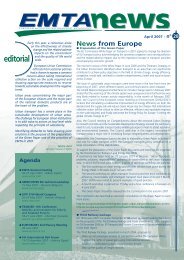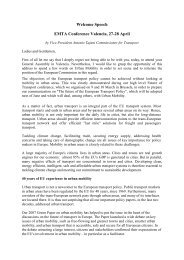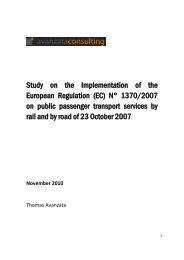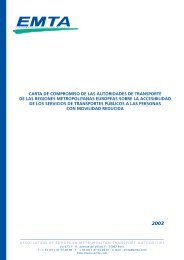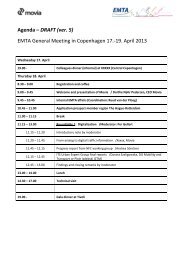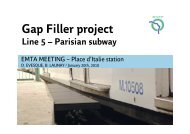Mobility Plans: the way forward for a sustainable urban ... - EMTA
Mobility Plans: the way forward for a sustainable urban ... - EMTA
Mobility Plans: the way forward for a sustainable urban ... - EMTA
Create successful ePaper yourself
Turn your PDF publications into a flip-book with our unique Google optimized e-Paper software.
consistency in planning says AMMT Torino,<br />
which adds that municipalities enjoy <strong>the</strong><br />
process feeling that <strong>the</strong>y are better heard<br />
than in <strong>the</strong> previous planning process at<br />
higher level.<br />
The intricacy of inscribing <strong>the</strong> <strong>Mobility</strong><br />
<strong>Plans</strong> into a wider national planning<br />
frame, with same objectives but different<br />
selected targets or time frames,<br />
may generate constraints. Sheffield<br />
emphasizes that targets are chosen locally<br />
in <strong>the</strong> LTPs, however <strong>the</strong>y must contribute<br />
to national targets and sometimes all interests<br />
aren’t going in <strong>the</strong> same direction.<br />
Sheffield gives <strong>the</strong> example of Manchester<br />
where <strong>the</strong> LTP contemplated to setting a<br />
road charging in order to decrease congestion,<br />
but <strong>the</strong> local population didn’t agree<br />
to <strong>the</strong> proposition, so <strong>the</strong> Manchester LTP<br />
had to find ano<strong>the</strong>r <strong>way</strong> to reach <strong>the</strong> goal.<br />
In <strong>the</strong> same <strong>way</strong>, to reconcile national and<br />
local objectives, especially when local<br />
partners have different time-frame horizons<br />
can prove difficult. Sheffield gives <strong>the</strong><br />
example of suppliers of transport services<br />
which are private and operate on a oneyear<br />
basis, <strong>the</strong>y need to secure profit. This<br />
doesn’t fit very well into <strong>the</strong> three to five<br />
years planning of <strong>the</strong> LTPs.<br />
There is also <strong>the</strong> risk, says CENTRO from<br />
Birmingham, that various short term<br />
measures don’t add up necessarily in a<br />
consistent result in a longer term perspective.<br />
All <strong>the</strong> more it is difficult to deliver a major<br />
scheme within <strong>the</strong> five years range of an<br />
LTP, especially in case of problems of land<br />
use or economic crisis and <strong>the</strong>n little space<br />
is left to maneuver towards alternative<br />
schemes, stresses again Sheffield.<br />
Several Transport Authorities actually enjoy<br />
a high level of integrated competencies,<br />
beyond <strong>the</strong> pure public transport, to reach<br />
numerous aspects of mobility activity. TfL is<br />
a good example. As a matter of fact, a<br />
recent law passed in <strong>the</strong> UK (December<br />
2008) will result in <strong>the</strong> evolution of Public<br />
Transport Authorities into Integrated Transport<br />
Authorities extending competencies over<br />
high<strong>way</strong>s and freight management. When<br />
asked if this higher level of integration is<br />
<strong>the</strong> solution to get things work better, <strong>the</strong><br />
answer is that it certainly helps, but is not<br />
sufficient. Ano<strong>the</strong>r main point of <strong>Mobility</strong><br />
<strong>Plans</strong> is <strong>the</strong> delivery of measures and that<br />
happens at local level.<br />
This remark brings us to consider more<br />
closely <strong>the</strong> municipal level. Municipalities<br />
are crucial actors in achieving <strong>sustainable</strong><br />
mobility and in particular medium sized to<br />
small municipalities surrounding <strong>the</strong> main<br />
city. First of all, this is where <strong>the</strong> modal<br />
share of motorized trips goes as far as<br />
80% in favor of <strong>the</strong> private car (in Madrid<br />
metropolitan area <strong>for</strong> example) while<br />
length of trips are in <strong>the</strong>ir majority under 5<br />
to 7km. Typically a large part of those trips<br />
could be done by soft modes like cycling<br />
or walking and <strong>for</strong> <strong>the</strong> longest of <strong>the</strong>m<br />
by public transport. The real challenge to<br />
reverse <strong>the</strong> trends towards more <strong>sustainable</strong><br />
mobility lies with <strong>the</strong> medium size to small<br />
cities within <strong>the</strong> metropolitan area.<br />
Secondly <strong>the</strong>y often draw <strong>the</strong>ir <strong>Mobility</strong><br />
sub-<strong>Plans</strong> that have to be consistent with<br />
<strong>the</strong> regional document, hence <strong>the</strong> guidelines<br />
issued by <strong>the</strong> metropolitan Transport<br />
Authorities, as in Barcelona and Ile-de-France.<br />
Besides it is at local level that citizens give<br />
<strong>the</strong>ir comments through debates organized<br />
by <strong>the</strong> municipalities. There<strong>for</strong>e, as STIF Ile<br />
de France points out, <strong>the</strong>y need to be<br />
convinced of <strong>the</strong> relevance of specific<br />
measures and on <strong>the</strong> o<strong>the</strong>r hand,<br />
understand that <strong>the</strong>ir action will impact<br />
<strong>the</strong> <strong>Mobility</strong> Plan at regional level.<br />
Thirdly <strong>the</strong>y are <strong>the</strong> ones who implement<br />
<strong>the</strong> measures agreed upon. However <strong>the</strong>re<br />
is a need <strong>for</strong> expertise and training of<br />
technicians, <strong>for</strong> one part and <strong>the</strong>re is a<br />
need <strong>for</strong> money <strong>for</strong> <strong>the</strong> o<strong>the</strong>r part.<br />
Municipalities are “<strong>the</strong> end of <strong>the</strong> chain”,<br />
but <strong>the</strong>y shouldn’t be <strong>the</strong> weakest point.<br />
The Financial issue<br />
<strong>Mobility</strong> plans are mainly strategic documents,<br />
<strong>the</strong>y are not investment planning<br />
document, although among <strong>the</strong> measures<br />
agreed upon and depending on local<br />
circumstances, <strong>the</strong>y can include some<br />
investment schemes, usually not major<br />
ones. But again it depends on local<br />
circumstances. The case of Warsaw is<br />
somehow specific where <strong>the</strong> necessity to<br />
modernize and upgrade <strong>the</strong> whole<br />
transport system led to <strong>the</strong> laying out of<br />
major investment schemes like <strong>the</strong> building<br />
of metro line 2, aside <strong>the</strong> mobility plan,<br />
within <strong>the</strong> general strategy.




